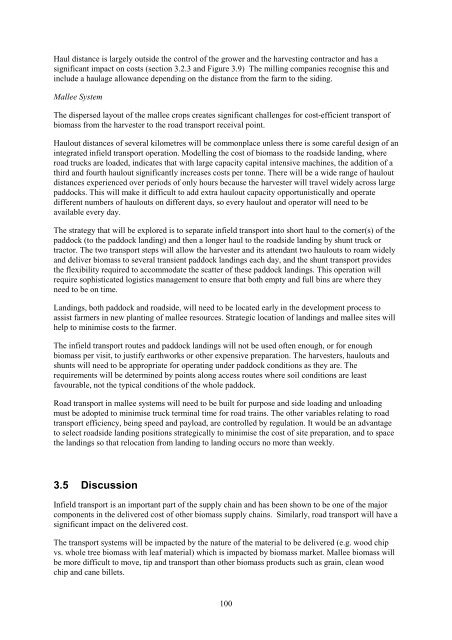Download (4Mb) - USQ ePrints - University of Southern Queensland
Download (4Mb) - USQ ePrints - University of Southern Queensland
Download (4Mb) - USQ ePrints - University of Southern Queensland
You also want an ePaper? Increase the reach of your titles
YUMPU automatically turns print PDFs into web optimized ePapers that Google loves.
Haul distance is largely outside the control <strong>of</strong> the grower and the harvesting contractor and has a<br />
significant impact on costs (section 3.2.3 and Figure 3.9) The milling companies recognise this and<br />
include a haulage allowance depending on the distance from the farm to the siding.<br />
Mallee System<br />
The dispersed layout <strong>of</strong> the mallee crops creates significant challenges for cost-efficient transport <strong>of</strong><br />
biomass from the harvester to the road transport receival point.<br />
Haulout distances <strong>of</strong> several kilometres will be commonplace unless there is some careful design <strong>of</strong> an<br />
integrated infield transport operation. Modelling the cost <strong>of</strong> biomass to the roadside landing, where<br />
road trucks are loaded, indicates that with large capacity capital intensive machines, the addition <strong>of</strong> a<br />
third and fourth haulout significantly increases costs per tonne. There will be a wide range <strong>of</strong> haulout<br />
distances experienced over periods <strong>of</strong> only hours because the harvester will travel widely across large<br />
paddocks. This will make it difficult to add extra haulout capacity opportunistically and operate<br />
different numbers <strong>of</strong> haulouts on different days, so every haulout and operator will need to be<br />
available every day.<br />
The strategy that will be explored is to separate infield transport into short haul to the corner(s) <strong>of</strong> the<br />
paddock (to the paddock landing) and then a longer haul to the roadside landing by shunt truck or<br />
tractor. The two transport steps will allow the harvester and its attendant two haulouts to roam widely<br />
and deliver biomass to several transient paddock landings each day, and the shunt transport provides<br />
the flexibility required to accommodate the scatter <strong>of</strong> these paddock landings. This operation will<br />
require sophisticated logistics management to ensure that both empty and full bins are where they<br />
need to be on time.<br />
Landings, both paddock and roadside, will need to be located early in the development process to<br />
assist farmers in new planting <strong>of</strong> mallee resources. Strategic location <strong>of</strong> landings and mallee sites will<br />
help to minimise costs to the farmer.<br />
The infield transport routes and paddock landings will not be used <strong>of</strong>ten enough, or for enough<br />
biomass per visit, to justify earthworks or other expensive preparation. The harvesters, haulouts and<br />
shunts will need to be appropriate for operating under paddock conditions as they are. The<br />
requirements will be determined by points along access routes where soil conditions are least<br />
favourable, not the typical conditions <strong>of</strong> the whole paddock.<br />
Road transport in mallee systems will need to be built for purpose and side loading and unloading<br />
must be adopted to minimise truck terminal time for road trains. The other variables relating to road<br />
transport efficiency, being speed and payload, are controlled by regulation. It would be an advantage<br />
to select roadside landing positions strategically to minimise the cost <strong>of</strong> site preparation, and to space<br />
the landings so that relocation from landing to landing occurs no more than weekly.<br />
3.5 Discussion<br />
Infield transport is an important part <strong>of</strong> the supply chain and has been shown to be one <strong>of</strong> the major<br />
components in the delivered cost <strong>of</strong> other biomass supply chains. Similarly, road transport will have a<br />
significant impact on the delivered cost.<br />
The transport systems will be impacted by the nature <strong>of</strong> the material to be delivered (e.g. wood chip<br />
vs. whole tree biomass with leaf material) which is impacted by biomass market. Mallee biomass will<br />
be more difficult to move, tip and transport than other biomass products such as grain, clean wood<br />
chip and cane billets.<br />
100
















